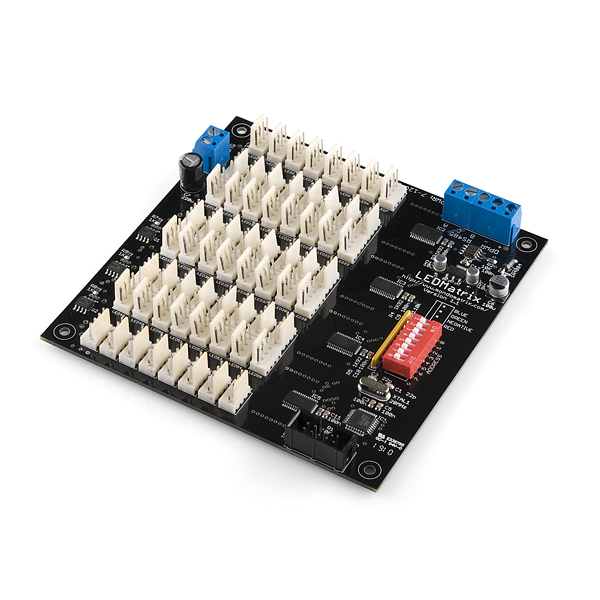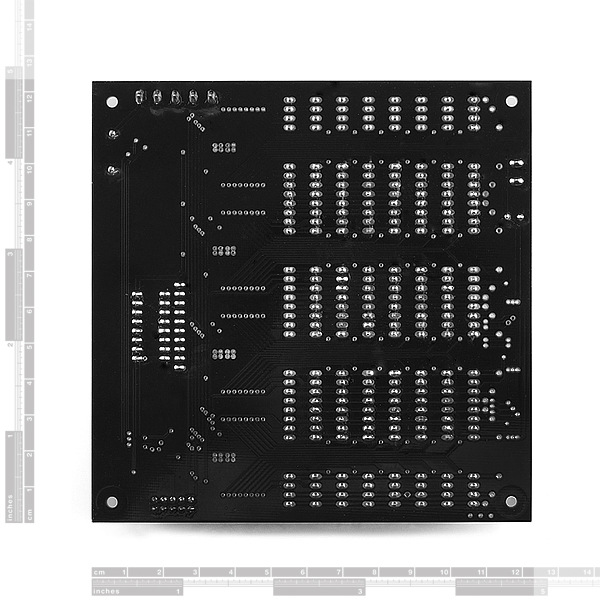×
SparkFun will be closed Nov. 28th and Nov. 29th in observance of Thanksgiving. Any orders qualifying for same day shipping placed after 2:00 p.m. MST on Wednesday, Nov 27th will be processed on Monday, Dec 1st. Wishing you a safe and happy holiday weekend from all of us at SparkFun!
MondoMatrix - LEDMatrix
Replacement: None. We are no longer carrying this board. This page is for reference only.
The LEDMatrix is a MondoMatrix expansion board that can control up to 64 tri-color RGB (4pin) LEDs. The board can also be used to control 192 individual LEDs. Each LED can be controlled to have a degree of luminance between 0 and 255. This means that you can have one tri-color RGB LED (per ‘port’) that has color values between 0 and 255 for each of the three colors. Using color codes, you can then make a huge variety of colors using RGB color values. You can also have three individual LED’s on each ‘port’ that can have a luminance value in the range of 0 (all the way off) to 255 (all the way on). The LED matrix has a separate power port for the board itself and the LEDs. This means that you can use a wide range of LEDs (ranges in voltage). It also protects the board from power related events that can harm the controllers.
- LED Drive Current: approx. 20ma
- Maximum recommended LED voltage drop: 4V
- Maximum recommended LED input voltage: 5V
- Input voltage range for the board power inputs: 7V – 12V DC in, 100mA
- Power consumption for LEDs on a full board: approx 1.3A
- Data interface: approx. 115.2 kbps (113.636kbps actual), 1 start bit, 1 stop bit, 9 data bits, MatrixNet V1 protocol
- 256 discrete levels of brightness control
- 4.8x4.8"
(video)(video)(video) * Product Page * Art Project using MondoMatrix Products
MondoMatrix - LEDMatrix Product Help and Resources
Comments
Looking for answers to technical questions?
We welcome your comments and suggestions below. However, if you are looking for solutions to technical questions please see our Technical Assistance page.
Customer Reviews
No reviews yet.





Can anyone tell me which female connectors to buy (64!) for this board? It's unclear from the pictures.
The board uses a fairly standard 0.100" 4-pin polarized header - PRT-08097 and PRT-08100 should work.
Thanks for the info. These are some sweet, well thought out boards that are going to make my wallet scream for mercy. Can't wait to see the Power and Sound Matrix boards, too! Already the ideas are popping like firecrackers. Great work!
MOLEX 5051-4
I just wanted to chime in that while these boards are retired from sparkfun, they are not in fact retired at all. I have a max patch available on my website: i brill dot com for driving these without the need for a displayduino, using a sparkfun usb-rs485 converter and I am purchasing them regularly through mondomatrix, directly.
I can't seem to find the main controller board product, the Displayduino on this site anymore?
This is designed for command anode correct am I right
Nope, common cathode. Check out the product page.
Are you planning on upping the game using 16 I/O chips instead of 8?
Are you allowed to release the chip number?
We don't make the board, so we can't say if it will get revised. Also, contact MondoMatrix for the IC they use. You can get to their site through the 'product page' link above.
Any word on a schematic? Or at least what strategy they are employing?
Interesting board. I was actually going to build something very similar to it when I got the cash to buy the parts I need (unemployment sucks).
It looks like this board is based off a ti 16 channel 12bit pwm led driver. I was going to use the ti59401 in my design but the price has gone way up and its hardly available in quantities other than samples from TI. Multiplexing each output to 3 leds cuts down on the number of driver chips to 4 at the expense of sending 3 times the data down the serial lines and led brightness. Adding that micro in the corner separates the end user from the somewhat complex interface to the led drivers and allows for scripts or led sequences to be initiated by a single command from outside.
I haven't bothered to take a look at the servo controller but if I remember correctly, TI has an appnote on using these drivers for that purpose making for a very similar board.
We don't make it, so we don't have a schematic. You can find out more information directly through the manufacturer. Ask them and see what you can come up with, good luck!